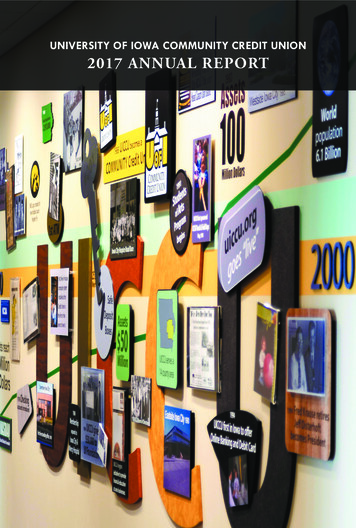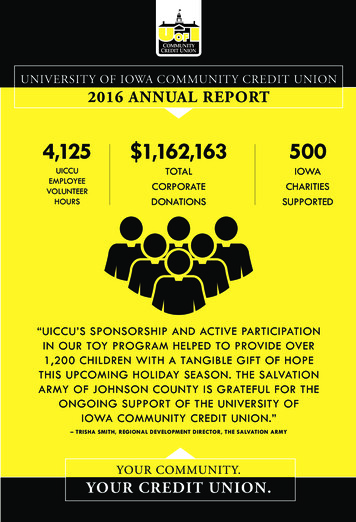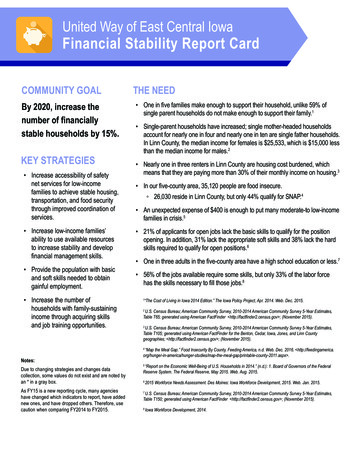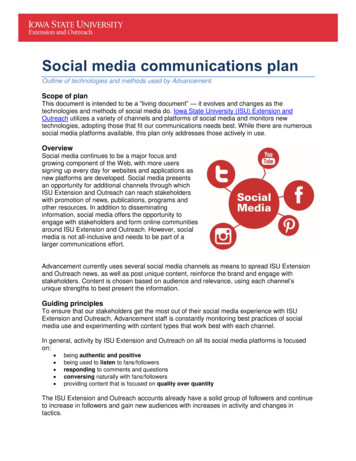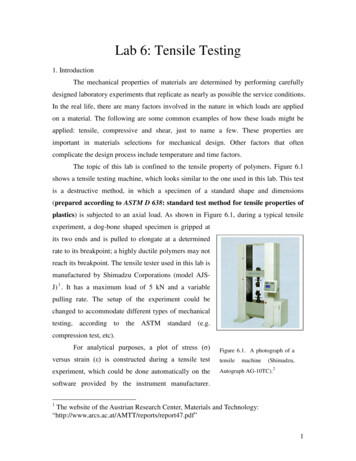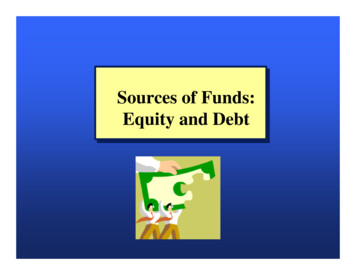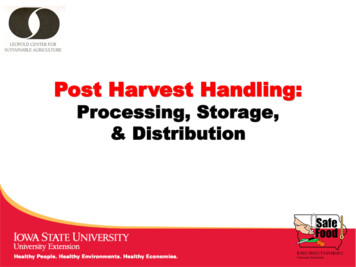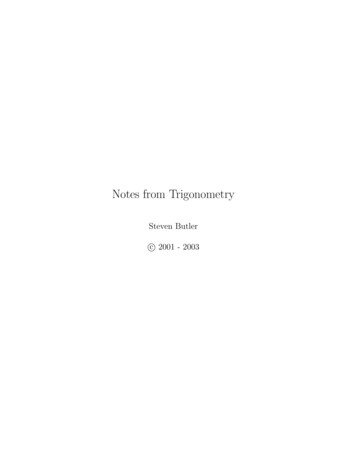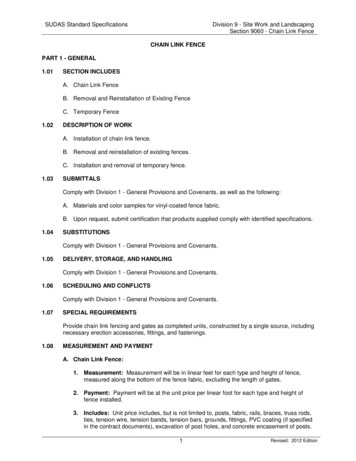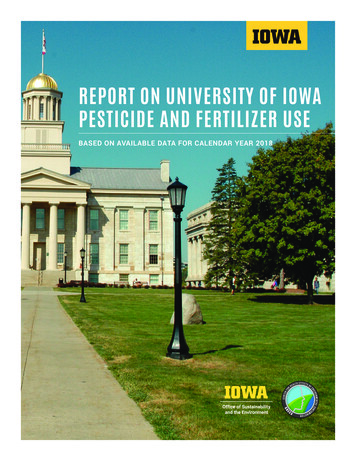
Transcription
REPORT ON UNIVERSITY OF IOWAPESTICIDE AND FERTILIZER USEBASED ON AVAILABLE DATA FOR CALENDAR YEAR 2018
REPORT ON 2018 UNIVERSITY OF IOWA PESTICIDE AND FERTILIZER USEREPORT CONTENTSACKNOWLEDGMENTSThis report was authorized bythe Center for Health Effects ofEnvironmental Contaminants(CHEEC) and the University of Iowa’sOffice of Sustainability and TheEnvironment(OSE) and prepared byProfessor David Cwiertny, Directorof CHEEC; Darrin Thompson,Associate Director of CHEEC; StratisGiannakouros, Director of OSE; BlakeRupe, Programs Manager of OSE;and Guadalupe Muñoz Rocha, CHEECand OSE Project Lead.The individuals listed below provideddata or other assistance for thisreport. Their cooperation, effort andtime are greatly appreciated.UNIVERSITY OF IOWA1Introduction4Commitment to Public and Environmental Health5Methodology8Result Details11Recommendations and Next Steps14ReferencesFIGURES AND TABLES2FIGURE 1. Pentacrest photos5FIGURE 2. UI Landscaping Services Tree Crew receivingtheir 9th Tree Campus USA award6TABLE 1. Locations services by the applicatorsmentioned in this report in 20188TABLE 2. Total commercial product (gallons) by functionapplied by each applicator8FIGURE 3. Percent contribution of total commercialpesticides applied in 20189TABLE 4. Pounds of acid equivalent applied on campusgrounds in 2018 for select UI applicators10TABLE 5. Total product applied (lbs) of mixed fertilizerand pesticide commercial productsFacilities ManagementDavid Brown, Manager ofManagement ServicesMatthew High, Groundskeeper forLandscaping ServicesMichael Rhinehart, LandscapeConstruction SupervisorShawn Fitzpatrick, Former AssistantManager of Landscaping ServicesScott Schrader, Groundskeeper forFacilities Management at OakdaleAthletic GroundsAnthony Senio, Sports Turf ManagerHousing and DiningTeri Sieve, Assistant Director forCustodial ServicesPurchasing DepartmentAaron Proctor, Purchasing AgentQuality CareGeoff Wilming, Vice President
REPORT ON 2018 UNIVERSITY OF IOWA PESTICIDE AND FERTILIZER USEINTRODUCTIONPESTICIDES ANDPUBLIC HEALTHThe 1994 Federal Insecticide,Fungicide and Rodenticide Act(FIFRA) defines a pesticide asany substance or mixture ofsubstances that is intended to beused for regulating plant growth anddefoliating plants or for preventing,destroying, repelling, or mitigatingany pests (1). The term includes,but is not limited to, herbicides,insecticides, fungicides, algaecidesand rodenticides.Pesticides were intentionally createdfor the control of pests and diseasecarriers responsible for public healthproblems and agricultural disasters.According to the EPA, pesticideshelp reduce and control vector-bornediseases, asthma and allergies,microbial contamination, avian flu,prions, and anthrax (2). However,pesticides can also pose risks topeople if not used, handled or storedproperly. According to the EPA,most people are rarely ever exposedto pesticide levels that can poseany risk, except pesticide workers(3). Currently, the EPA commits toefforts for the protection of pesticideworkers, endangered species, andpollinators and to reduce the numberof occurrences of a phenomenoncalled pesticide drift.At the state level, Chapter 45 of theIowa Administrative Code requirescommercial applicators to haverecords of all application activitiesand maintain these records for twoyears from the date of use of thepesticide (4). Such records containinformation about the license,landowner or customer, locationof application, the product used,the quantity applied, and weatherconditions during time of application.At the federal level, the EPA doesnot require private applicators tomaintain records. Under the EPAPlan for the Federal Certificationof Applicators of Restricted UsePesticides within Indian Country,also known as the 2014 EPA Plan,commercial applicators must alsoinclude the information listed aboveabout any restricted-use pesticidesand would also keep these recordsfor two years if they apply pesticidein “areas of Indian country” coveredby the plan (5). Under the 1990 FarmBill, the United States Departmentof Agriculture (USDA) also requiresall private pesticide applicators tokeep records of their use of federallyrestricted-use psesticide applicationsfor two years (6).1Through FIFRA the Secretary ofAgriculture can collect statewide orregional data on the use of pesticidesto control pests and diseases fromsurveys of farmers and other sources(1). The USDA oversees the PesticideData Program, a national pesticideresidue database program, focusingon the pesticide residues in theU.S. Food Supply (7). Additionally,the U.S. Geological Survey (USGS)provides estimates of agriculturalpesticide use for many pesticidesat the state and county level (8).This data is based on surveys andestimates of harvested crop acrescollected for the Pesticide NationalSynthesis Project (8). The EPA Officeof Pesticide Programs developed areport providing the expenditures,volume of pesticide applied, numberof pesticides and applicators forthe years 2008-2012 (9). It has beenthe only report since then. However,there is no pesticide use reportingthat is comprehensive enough toinclude home-and-garden, industrial,institutional and agricultural use.
REPORT ON 2018 UNIVERSITY OF IOWA PESTICIDE AND FERTILIZER USE INTRODUCTIONMOTIVATION FOR THISREPORTthe practices of the pesticideapplications on campus lawns.The Pentacrest, the heart of campus,is known for its green turfgrassalmost year-round. However, theeffort, money, labor, and chemicalsput into maintaining this turfgrassmay be taken for granted by many.The Pentacrest is just one areaon the UI campus that requireslawn care and maintenance. TheUniversity of Iowa spans acrossmore than 1,900 acres of whichjust over 15% is maintained turf.It is also home to 8,000 trees and24 acres of planted beds. Thoughsome appreciate the greenery andaesthetic of the campus, therecontinues to be concerns overOver Labor Day weekend in 2019,UI Landscaping Services treatedPentacrest lawns with fertilizersand herbicides. As required by thelaw, signs were placed on the lawnsto make students, faculty, staff andother University of Iowa communitymembers aware of the risk ofchemical exposure. Despite thesignage, some individuals accessedthe Pentacrest lawns and sat onthe grass, drawing media attentionfrom the Daily Iowan (“UI treats lawnswith chemicals, students unaware ofhealth risks”) (10). A similar incidentalso occurred in 1990 when the UIFIGURE 1. (Top)Students sitting ongrass during 2019Labor Day weekendregardless of yellowsigns warning of recentlychemically treatedlawn. Photo Credit:Katie Goodale. (Bottom)Students walking on thePentacrest in 1990 nearlawn with yellow signwarning students to keepoff. Photo Credit: RandyBardyEnvironmental Coalition expressedconcerns over the size of the signsposted after pesticide applicationand lack of publicly availableinformation about such applicationby UI Landscaping Services (11).Importantly, in both cases, all UILandscaping Services’ practiceswere in accordance to Chapter 45 ofthe Iowa Administrative Code (12).As the number of sustainabilityconscious community membersgrows at the University of Iowa,the demand for action and datatransparency increases. Throughoutthe years, faculty, staff, students, andcommunity members have expressedtheir concerns over pesticideapplications on campus lawns withlittle known correspondence fromthe University. In 1994, the Universityof Iowa formed a pesticide andherbicide task force to investigatethe University’s use of pesticide andherbicides (13). However, there is noknown documentation of any studies,data, or information disseminated bythis task force. Today, such a taskforce no longer exists.Over the past several years andin response to these more highprofile application events, both theOffice of Sustainability and theEnvironment (OSE) and the Centerfor Health Effects of EnvironmentalContaminants (CHEEC) have receivednumerous inquiries about risksand the extent of pesticide use atthe University of Iowa. Motivatedby these inquiries and in response,both offices decided to sponsor aninterdisciplinary internship startingin the Fall of 2019 to collect datarelated to pesticide use on campus.2
REPORT ON 2018 UNIVERSITY OF IOWA PESTICIDE AND FERTILIZER USE INTRODUCTIONSCOPE AND GOALS OFTHIS REPORTWith the health and safety of theUI community at the forefront,this report was created toincrease awareness and providetransparency about the types andamounts of pesticide productsbeing applied across the UIcampus. This report does notprovide alternative options forany products used nor does itmake any claims about potentialrisks and benefits from any ofthe applications. This reportfocuses on lawns serviced byvarious UI operations and usesdata provided by and collectedfrom different lawn chemicalapplicators. Any limitations arenoted in the methodology.The overall goals of this report are:1. Determine the types, amounts and application locations of differentchemical pesticides and fertilizer used on the UI campus grounds.The data collected for pesticides are compared for each commercialapplicator based on:1. Acid Equivalent: This is the theoretical yield of a parent acid from apesticide active ingredient that has been formulated as a derivatese.g. esters, salts, amines.2. Function: This is a classification of pesticides based on thetargeted pest species. Functions include but are not limited toherbicide, insecticide, and fungicide.2. Identify opportunities to establish and standardize best practicesregarding pesticide use, information distribution, and stakeholderrelations. All stakeholders related to this project can help pave thepath for the University of Iowa to provide the campus environment thatstudents deserve. Any recommendations are based on practices byother schools, goals set by the state of Iowa, and those presented bycollaborators in this project3
REPORT ON 2018 UNIVERSITY OF IOWA PESTICIDE AND FERTILIZER USECOMMITMENT TO PUBLIC AND ENVIRONMENTAL HEALTHCHEEC and OSE both have distinct,but interrelated, missions thatstrive to improve and protectpublic and environmental health.CHEEC focuses on research andeducation regarding environmentalcontamination and associatedhuman health effects. OSE’s missionis to challenge and inspire the UIcommunity in striving for excellencein systems-based solutions for thegrand environmental challenges ofthe 21st century through impactfultransdisciplinary education, research,and service.CHEECCHEEC was established by mandatewithin the 1987 Iowa GroundwaterProtection Act with the mentionedmission. CHEEC focuses ondeveloping and maintainingenvironmental databasescommunicating health informationto the general public, cooperatingand collaborating on communityengaged programs and projects,and providing environmentalhealth expertise on state and localcommittees. CHEEC is comprisedof faculty from UI Departments ofCivil and Environmental Engineering,Epidemiology, Occupational andEnvironmental Health, Chemistry,Geographical and SustainabilityScience, and the State HygienicLaboratory. This project wasmade possible through theirongoing Education, Outreach, andEngagement efforts.OSE2030 SUSTAINABILITY GOALSOSE’s mission is to challenge andinspire the greater University ofIowa community—through impactfultransdisciplinary education,research and artistry, and publicengagement—to strive for excellencein creating and maintaining systemsbased solutions for the grandenvironmental challenges of the21st century. OSE provides a basefor coordinating sustainability-andenvironment-related programsacross the university community,including sustainability educationand research. OSE support’sconnections among existingacademic programs, faculty research,and outreach efforts, as well asthe coordination of initiatives for amore sustainable community. OSE’sgoals include building and improvingpartnerships that work towards asustainable Iowa, advocating forchanges to enhance operations toadapt and combat the effects ofhuman-induced climate change,promote OSE and OSE partneradvancements in use-inspiredresearch, and assisting in creatingand promoting student opportunities.This project is part of their efforts inStudent Life, Outreach, Research, andCampus engagement.On May 2020, the OSE announcedthe framework for campus-widesustainability goals to be met by2030. One of the goals includesusing the campus a “livinglaboratory” for sustainabilityeducation and exploration. In thisgoal, the UI will develop goals toincrease opportunities for studentsand researchers to use the UIcampus as an educational andresearch laboratory for improvementof campus sustainabilityand ecosystems. This couldreasonably include implementingrecommendations made in thisreport.4
REPORT ON 2018 UNIVERSITY OF IOWA PESTICIDE AND FERTILIZER USEMETHODOLOGYOVERVIEWPesticide use information wasobtained directly from UI applicators(see below) and was recorded in aMicrosoft Excel spreadsheet thatserved as a chemical inventoryto perform calculations related topesticide application.DATA SOURCESThe data sources collected werefrom calendar year 2018. Applicatorsconsidered for this project had to beemployed or contracted by the University of Iowa or any of its units, departments, or offices to provide lawn careto facilities or grounds essential tomajor University of Iowa operations.According to Iowa Code, acommercial applicator refers to aperson, company or employee of aperson or corporation that in someform or another applies pesticide onproperty or land for another entityas a business. This definition doesinclude exceptions for farmers andtheir employees. To distinguishbetween the companies and theindividuals, this report refers tocommercial applicators as thosedepartments and businesses thatare in contract with the University toprovide lawn care. Individuals whoare certified and authorized to useany pesticide will be referred to ascertified applicator as per Iowa Code.Pesticide and fertilizer usage datafor this report was provided by thefollowing commercial applicators:Commercial ApplicatorsUI Landscaping Services is a branchof Facilities Management for themain campus led by Scott Gritsch.The landscaping services team,composed of over 40 employees,oversees the turf program, flower bedinstallation and maintenance, litterand waste removal, and snow and iceremoval. This team is composed ofpeople with different backgrounds inforestry, horticulture, and landscapedesign. They are responsible for290 acres of maintained turf, 8,000trees, and many miles of sidewalks,bike paths, and roads. For the past11 years, Landscaping Services hasearned the honor of Tree CampusUSA Award. This award is given tocampuses that have a campus treeadvisory committee, a campus treecare plan, a campus tree programwith dedicated annual expenditures,an annual Arbor Day Observance,and a service-learning project toengage the student body (15). In2018, UI Landscaping Servicesreleased its Landscape ServicesManagement Plan. The plan wascreated in order to define appearanceexpectation, establish standards formaintenance and provide a structurefor monitoring results (16). The planalso included information about theservices areas, rate of applicationfor chemicals in 2018 turf programand maps detailing the areas servedby Landscaping Services, and theirpriority designation. Note that theturf program in the plan is subject tochange throughout the years basedon new information, environmentalconditions, goals, and budgets.UI Athletic Grounds oversees athleticgrounds under the University of IowaAthletics Department.FIGURE 2. UILandscaping ServicesTree Crew receivingtheir 9th TreeCampus USA awardin at the 28th AnnualCommunity ForestAwards Luncheon inDes Moines in 2018.Photo source: UIlandscaping ServicesFacebook.5
REPORT ON 2018 UNIVERSITY OF IOWA PESTICIDE AND FERTILIZER USE METHODOLOGYQuality Care-The Nature Companyis contracted out by the Universityof Iowa Housing and Dining unit toperform lawn care, landscape andpond maintenance, and snow andice removal. Thus, their services areused year-round.Lawn chemical applicators whosedata were requested but were notreceived in time to be included in thisreport include:(1) University of Iowa FacilitiesManagement at Oakdale(2) Jan’s Lawn Care contracted byHeritage Property Management(3) The University of Iowa Hospitaland Clinics main campusLOCATIONSThis inventory reports 2018 pesticideand fertilizer applications for theapplications listed in Table 1.TABLE 1. LOCATIONS SERVICES BY THE APPLICATORS MENTIONED IN THIS REPORT IN 2018a,bHOUSINGFACILITIESRECREATIONAL ANDATHLETIC FACILITIESBurgeResidence HallBeckwith BoathouseCatlett HallResidence HallCurrierResidence HallDaumResidence HallHillcrestResidence HallCampus Recreationand Wellness CenterElliot ParkField HockeyField HouseGerdin AthleticLearning CenterGibson Square ParkMayflowerResidence HallHansen FootballPerformance CenterPetersenResidence HallHubbard ParkPresident’sResidenceRienowResidence HallSlaterResidence HallStanleyResidence HallKinnick StadiumUniversity of IowaAthletics Hall of FameLEARNING FACILITIESSERVICES FACILITIESOPEN SPACESAlder Journalism andMass CommunicationBuildingHancher AuditoriumPentacrestIowa Memorial Union(IMU)Quad Ravine/ SkunkHollowBecker CommunicationStudies BuildingBiology BuildingBoyd Law BuildingCalvin HallDental Science BuildingEnglish PhilosophyBuildingIowa AdvancedTechnology LaboratoriesMain LibraryNursing BuildingObermann Center forAdvanced StudiesIowa Memorial UnionParking RampLandscape ServicesComplexMossman BusinessServices BuildingUniversity of IowaAircare MaintenanceFacilityUniversity of IowaHealth Care-Iowa RiverLandingUniversity of IowaResearch ParkPappajohn BusinessBuildingSeamans CenterSeashore HallTheatre BuildingWendell JohnsonSpeech and HearingCentera Locations excluded from the applicators mentioned in this report include: (1) UI Finkbine Golf Course and Clubhouse overseen by UI AthleticsGrounds and UI Parking & Transportation Facilities overseen by Landscaping Services, except the IMU Parking Ramp.b Locations overseen by lawn applicators whose datasets are not present are unknown.6
REPORT ON 2018 UNIVERSITY OF IOWA PESTICIDE AND FERTILIZER USE METHODOLOGYDATA TYPESPesticide and Fertilizer Usage DataPesticide and fertilizer usage datawas collected directly from thecommercial applicators identifiedabove. Recordkeeping of pesticideand fertilizer applications ismandatory by state and federal law.Currently, none of the UI applicatorsin this report use restricted usechemicals. Data collected from eachapplicator included some or all thefollowing information: Name of commercial productDate of applicationCost per applicationLocation of applicationRates per areaQuantities appliedPurpose of applicationTools used for applicationSafety Data Sheets and EPAApproved Label SheetsSafety data sheets and EPAApproved Label Sheets wereobtained from the manufacturerwebsites, distributors, and EPA’sPesticide Product and Label System.Safety Data Sheets (SDS), alsoknown as material safety datasheets and product safety datasheets, provide basic informationof a chemical product such as theproperties of each chemical; thephysical, health, and environmentalhealth hazards; protective measures;and the safety precautions forhandling, storing and transportingthe chemical (7). EPA ApprovedLabel Sheets are documents thatthe EPA must approve under FIFRAthat contain information regardingthe conditions, directions andprecautions needed to apply thepesticide (18).Quantity and Use CalculationsIn this report two different valuesrelated to pesticide quantitiesare discussed: total commercialproduct and total acid equivalent.Total commercial product refersto the total amount of productthat contains both active and inertingredients. Most applicators applybased on the actual commercialproduct. However, this can beconverted to acid equivalent oreven active ingredient quantities.7Total acid equivalent refers to thetotal amount of the parent
REPORT ON 2018 UNIVERSITY OF IOWA PESTICIDE AND FERTILIZER USE INTRODUCTION 3 The overall goals of this report are: 1. Determine the types, amounts and application locations of different chemical pesticides and fertilizer used on the UI campus grounds. The data collected for pesticides are compared for

